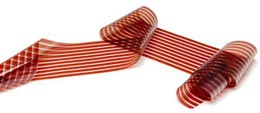One day you will get anything you want without going to local supermarket. The only thing you’d have to buy will be an inkjet printer. Using it, you will not just print images and text, but also get yourself other stuff for very day life.
The scientists have adopted the inkjet printer for printing electric circuits, artificial bones, blood vessels and body organs. Yet, inkjet printing proves versatile technology for creating other non-imaging products.
A Massachusetts, US-based company Konarka Technologies has announced that it has successfully manufactured solar cells using inkjet printing technology. Using the existing and very simple technologies of an office inkjet printer, Konarka has replaced ink with the solar cell material, and paper with a thin flexible sheet of plastic.

Here is how it works. The printhead of an inkjet printer deposits a solar cell material into a thin flexible plastic sheet. According to the company, the process creates solar cells which are almost as good as the silicon ones, created with more advanced technologies. The beauty of the new method is that it makes solar panel much cheaper, as it uses existing, generally accepted technology and requires no special clean premises.
Multiple colors can be added to “ink” to print patterns onto the cells, customizing them for different environments. Konarka says the technology may ultimately produce solar cells to generate energy from both sunlight and indoor light, and to supply lower power devices, like indoor or sensor applications.
The flexibility of the solar cells allows for a variety of locations where traditional solar panels could not be installed. Moreover, Rick Hess, president and CEO of Konarka, said in an interview to PopularMechanics.com that they “constantly receive calls from innovators who have read about the cells and propose unique—sometimes wild and crazy—concepts for the technology.”
For the moment, the inkjet printing is only feasible for large productions of solar cells. First consumer products are not likely to appear within next two years.
